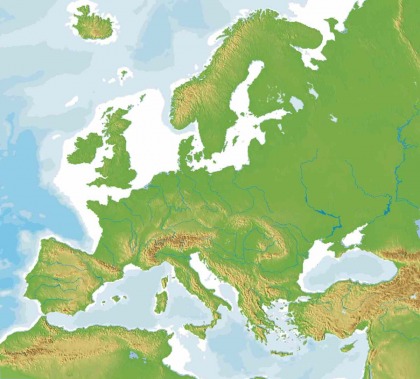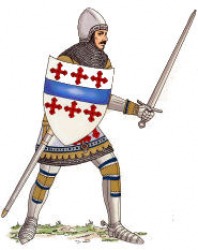
Vocabulary
friars - people who belonged to religious orders but lived and worked among the general public
clergy - church officials
religious order - a group of people who dedicate their lives to religion and follow common rules
heresy - religious ideas that oppose accepted church teachings
natural law - law that governed how the world operated
excommunicate - to cast out from the church
Holy Land - region where Jesus had lived, reaches, and died; home of Crusades
Hundred Year's War - long conflict between England and France
Black Death - deadly plague that swept through Europe between 1374 and 1351; 27 million people killed
Crusades - a long series of wars between Christians and Muslims over the Holy Land
Spanish Inquisition - organization of priests that looked for and punished non-Christians in Spain
Parliament - law making body that governs England today; supports kings
Reconquista - Christian kingdoms' efforts to retake Spain from the Moors
Magna Carta - document listing rights that the king could not ignore
Important People
King Richard I (1157-1199) - led Christian soldiers on Third Crusade (vs. Saladin)
Saladin (1137 - 1193) - led Muslim forced during Third Crusade against King Richard
Pope Gregory VII (1020-1085) - fought with Holy Roman Emperor Henry IV over the power to chose church officials
Emperor Henry IV (1050-1106) - fought against Pope Gregory VII over power to chose church officials; was excommunicated
King Ferdinand - completed Reconquista; banned Islam and forced all Jews become Christian or leave
Queen Isabella - helped her husband complete the Reconquista; paid for voyages of Christopher Columbus
Pope Urban II (c.1035-1099) called on Christians to launch First Crusade
Joan of Arc (c.1412-1431) - French peasant girl who rallied French troops during the Hundred Years' War
Thomas Aquinas (1225-1274) - Dominican philosopher who argued that rational thought could be used to support Christian belief
Francis of Assisi (c.1182-1126) - Italian saint who encourages people to be kind to others; founded Franciscan Order
Geography

Europe is part of the landmass Eurasia, which includes both Europe and Asia. The Ural Mountains tend to be the dividing line between the two continents. If you look at the map, you can see that the topography of Europe is incredibly diverse. Southern Europe is made up of mountain ranges, like the Alps. Northern Europe basically included the Northern European Plain, which expands from the Atlantic Ocean in the west all the way to the Ural Mountains in the east.Here, many trees and forests are located, along with major rivers and farms. Up above Northern Europe lies what is known as Far Northern Europe, which has many hills and mountains, though not as high as the Southern Europe's. Now, if you look at Europe as a whole, you can see that it is mainly made of of peninsulas. Peninsulas are lands that are surrounded by water on three sides. Islands like Ireland and Britain are surrounded completely by water, but countries like Spain (Iberian Peninsula), Italy (Italian Peninsula), and Scandinavia (Scandinavian Peninsula) are considered some of the Europe's most well known peninsulas.
Religion

At the beginning of the Middle Ages, only places that had been part of the Roman Empire were Christian. Thanks to popes and missionaries, however, Christianity spread all throughout Europe. The popes ordered the missionaries to different parts of the continent, where they tried to convert other people to Christianity. Saints are the most famous of the missionaries, like Saint Patrick. These people were incredibly devoted to their religion and helped lots of people to convert. Another branch of religious people were known as monks, who lived apart from everyone else in their own monasteries, or communities. They ran schools, copied books, collected ancient writings, and served as scribes to local rulers.
The picture at right shows the spread of Christianity. The dark blue represents mainly Christian cities in AD 325, while the light blue is where all the Christians were locates by AD 600.
Other facts:
*The worst punishment you could receive was to be excommunicated, or cast out from the church
*In small German states, emperors were considered protectors of the pope
*Christian monarchs ruled many European kingdoms, like France and England
*In the early 1200s, friars, or traveling monks who lived among the common people, became well known
*Heresy - religious ideas that opposed to the church teachings of the time
Achievements
Gothic Architecture - cathedrals with rose windows - stained glass windows; flying buttresses; painted arches
Art - paintings and tapestries on church walls and ceilings
Robes - highly decorated with threads made of gold
Books - bright colors on first letters and borders on pages; thin sheets of silver and gold
Universities - created by the church or groups of students in the 1200s
Monastery - communities of monks; had churches, farms, dormitories, infirmaries, and much more, all in one place
Feudalism - relationship between lords and knights, with protection in exchange for land (similar to that in Japan)
Crusades

The area of Palestine in Europe was known as the Holy Land during Medieval Europe. Christians believed that this was where Jesus had lived, preached, and died, and they certainly didn't want people of another religion living there. The Muslims, however, had been living there for quite some time. The dispute over the land caused the Christians to launch the Crusades, with the assistance of Pope Urban II. This series of wars was started in 1096, when Christian peasants set on the way to the Holy Land. Since the peasants were untrained and unequipped, Europeans had to send in knights and nobles. They fought better, and in 1099, had taken Jerusalem and set up four cities in the Holy Land. Their success didn't last, however; after only 50 years, Muslims started taking back the Holy Land. In response, the Europeans launched the second and third crusades. The second crusade was a complete failure, and the third barely fared much better. (King Richard I of England stated in the Holy Land, rivaling against Saladin, the leader of the Muslims. Even though King Richard lost, he gained the respect of both Christians and Muslims.) After over thirty years of fighting, the Holy Land was still in Muslim hands. The fourth crusade was the last large attempt, and it failed as well. In the end, the crusaders had to stop because of:
*Had to travel huge distances
*Crusaders couldn't adjust to desert climate
*Muslims outnumbered the Christians
*Christian leader started internal problems
Black Death

The Black Death was a deadly plague that came from Asia. The plague lived in the stomach of fleas, which lived on rats. The rats then entered the city and spread the disease to almost everyone in Europe. The Black Death entered Europe in 1374, and more than 27 million people had died by 1351. There were three types of plague, the bubonic (30-75% death rate), phemonic (90-95%), and septicamic (100%). The bubonic plague caused lymph glands to swell up, called boboes. At the time, there were many supposed cures, such as writing a prayer on paper, folding it seven times, then swallowing it. Now, however, it can be treated with antibiotics.
The Black Death had a huge effect on Europe. The manor system fell apart, and the remaining people could start charging money for their services. This was part of the beginning of the Renaissance.
Social Structure
Kings and Queens - greatest lords of Europe, and all nobles and knights were their vassals
Popes - one of the strongest people of the church; in charge of missionaries
Missionaries - sent by popes to spread Christianity
Nobles - vassals of kings and queens, though lords of lower-ranking nobles and knights
Lesser Nobles - not as powerful as nobles, but could still play the part of a lord to a knight
Knights - served and protected their lord in exchange for land
Peasants - farmers; not part of feudal system, for they owned no land
Serfs - Peasants who were tied to the land on which they worked; hired by knights to farm land
Compare & Contrast - Japan and Europe
Similarities --
*The main similarities between Europe and Japan lie in the feudal society. They both had lords and vassals, and knights and samurai. For more information, please click here. This will bring you to the comparison between feudalism and the knights and samurai.
Differences --
*Religion - Europeans were mainly Christian, while Japanese people were a blend of Buddhism, Shinto, and Confucianism
*Art - In Europe, everything was religion based with scenes from the Bible; Japan - nature; people in gardens
*Literature - As well as regular literature and novels (in both countries), Japan had haikus - short, three lined poems describing nature scenes
Animal of the Day: So, here lies a lamb. Other religions had used the lamb for sacrificial purposes, so the Christians took the lamb as a symbol of Christ, emphasizing his sacrifice for humanity. Oh, just ignore the tags and stuff on his ear. I'm just capturing the idea, not the animal! And they mainly used the lamb in paintings.
So, um, I guess that's it...Say hiiii!

